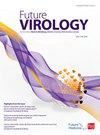The association of De Ritis ratio with the severity of Crimean–Congo hemorrhagic fever
IF 1.4
4区 医学
Q3 VIROLOGY
引用次数: 0
Abstract
Aim: This study aimed to present the characteristics and poor prognostic factors of Crimean–Congo hemorrhagic fever (CCHF) patients. Materials & methods: Adult patients (>18 years) with CCHF were included in this retrospective study. Demographics, risk scores and laboratory findings of survivors and nonsurvivors were compared. Results: Fifteen (9.2%) of 163 CCHF patients were nonsurvivors and had a higher Severity Score Index (p < 0.001), Severity Grade Score (p < 0.001) and De Ritis ratio (aspartate transaminase/alanine transaminase) (p < 0.001). De Ritis ratio was >3 in 10.1% of survivors and 53.3% of nonsurvivors (p < 0.001). In multivariate analysis, De Ritis ratio >3 (OR: 5.428, p = 0.045) and SGS (OR: 1.776, p = 0.005) were found as predictive factors. Conclusion: De Ritis ratio may predict prognosis in combination with severity risk scores in CCHF.德炎比值与克里米亚-刚果出血热严重程度的关系
目的:探讨克里米亚-刚果出血热(CCHF)患者的特点及影响预后的因素。材料与方法:本回顾性研究纳入成年CCHF患者(bb0 ~ 18岁)。对幸存者和非幸存者的人口统计、风险评分和实验室结果进行比较。结果:163例CCHF患者中有15例(9.2%)为非幸存者,严重程度评分指数(severe Score Index)较高(10.1%的幸存者为3,53.3%的非幸存者为3 (p = 5.428, p = 0.045)和SGS (OR: 1.776, p = 0.005)为预测因素。结论:De - Ritis比值可与CCHF严重危险评分联合预测预后。
本文章由计算机程序翻译,如有差异,请以英文原文为准。
求助全文
约1分钟内获得全文
求助全文
来源期刊

Future Virology
医学-病毒学
CiteScore
4.00
自引率
3.20%
发文量
84
审稿时长
6-12 weeks
期刊介绍:
Future Virology is a peer-reviewed journal that delivers essential information in concise, at-a-glance article formats. Key advances in the field are reported and analyzed by international experts, providing an authoritative but accessible forum for this ever-expanding area of research. It is an interdisciplinary forum for all scientists working in the field today.
 求助内容:
求助内容: 应助结果提醒方式:
应助结果提醒方式:


